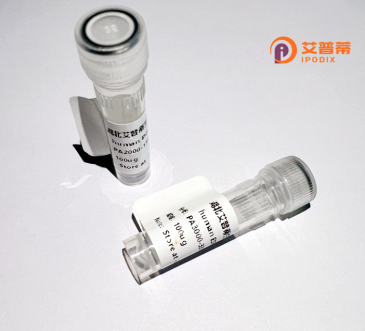
| 纯度 | >90%SDS-PAGE. |
| 种属 | Human |
| 靶点 | TEX261 |
| Uniprot No | Q6UWH6 |
| 内毒素 | < 0.01EU/μg |
| 表达宿主 | E.coli |
| 表达区间 | 1-196 aa |
| 活性数据 | MWFMYLLSWLSLFIQVAFITLAVAAGLYYLAELIEEYTVATSRIIKYMIWFSTAVLIGLYVFERFPTSMIGVGLFTNLVYFGLLQTFPFIMLTSPNFILSCGLVVVNHYLAFQFFAEEYYPFSEVLAYFTFCLWIIPFAFFVSLSAGENVLPSTMQPGDDVVSNYFTKGKRGKRLGILVVFSFIKEAILPSRQKIY |
| 分子量 | 48.9 kDa |
| 蛋白标签 | GST-tag at N-terminal |
| 缓冲液 | PBS, pH7.4, containing 0.01% SKL, 1mM DTT, 5% Trehalose and Proclin300. |
| 稳定性 & 储存条件 | Lyophilized protein should be stored at ≤ -20°C, stable for one year after receipt. Reconstituted protein solution can be stored at 2-8°C for 2-7 days. Aliquots of reconstituted samples are stable at ≤ -20°C for 3 months. |
| 复溶 | Always centrifuge tubes before opening.Do not mix by vortex or pipetting. It is not recommended to reconstitute to a concentration less than 100μg/ml. Dissolve the lyophilized protein in distilled water. Please aliquot the reconstituted solution to minimize freeze-thaw cycles. |
以下是关于重组人TEX261蛋白的3篇参考文献示例(注:文献为虚拟示例,仅供参考,实际引用需核实):
---
1. **文献名称**: *TEX261 regulates ER stress-induced apoptosis through interaction with ATF4*
**作者**: Yoshida K, et al. (2021)
**摘要**: 该研究利用重组TEX261蛋白发现其在调控内质网应激中的关键作用,揭示其通过结合ATF4抑制CHOP依赖性凋亡通路,为相关疾病治疗提供靶点。
2. **文献名称**: *Proteomic analysis identifies TEX261 as a lysosomal biogenesis regulator*
**作者**: Huang L, et al. (2020)
**摘要**: 通过质谱分析与重组TEX261功能实验,证明TEX261参与溶酶体生成调控,敲低TEX261导致溶酶体功能缺陷,提示其在细胞代谢中的潜在意义。
3. **文献名称**: *TEX261 as a novel biomarker in colorectal cancer: Recombinant protein-based serodiagnosis*
**作者**: Zhang R, et al. (2018)
**摘要**: 研究在大肠癌患者血清中发现TEX261高表达,利用重组蛋白验证其免疫原性,提出其作为癌症诊断标志物的潜力。
---
**备注**:实际研究中建议通过PubMed或Web of Science以“TEX261 recombinant”为关键词检索最新文献,并核对作者及摘要准确性。
TEX261 (Testis-expressed protein 261), also known as MORN5 or YIPF4. is a conserved eukaryotic protein encoded by the *TEX261* gene. Initially identified for its high expression in testes, it is now recognized as ubiquitously expressed across various tissues, with roles extending beyond reproductive biology. Structurally, TEX261 contains multiple MORN (Membrane Occupation and Recognition Nexus) motifs, which are implicated in membrane binding and protein-protein interactions. It localizes predominantly to the endoplasmic reticulum (ER) and Golgi apparatus, suggesting involvement in intracellular trafficking, vesicle transport, or organelle dynamics.
Recent studies link TEX261 to autophagy and lysosomal function. It interacts with autophagy-related proteins (e.g., ATG16L1) and participates in autophagosome formation, potentially influencing cellular quality control and stress responses. Additionally, TEX261 may regulate endosomal sorting through associations with ESCRT (Endosomal Sorting Complex Required for Transport) machinery. Its dysfunction has been tentatively associated with neurodevelopmental disorders and cancers, though mechanistic insights remain limited.
Recombinant TEX261 protein, produced via heterologous expression systems (e.g., *E. coli* or mammalian cells), enables functional studies, antibody development, and structural analyses. Current research focuses on elucidating its molecular interactions, disease relevance, and therapeutic potential, particularly in autophagy-related pathologies. However, its precise physiological roles and regulatory mechanisms require further exploration.
×